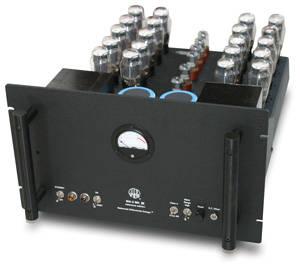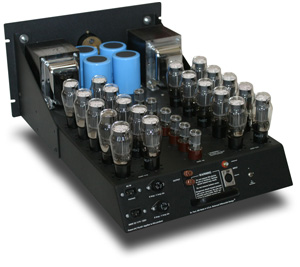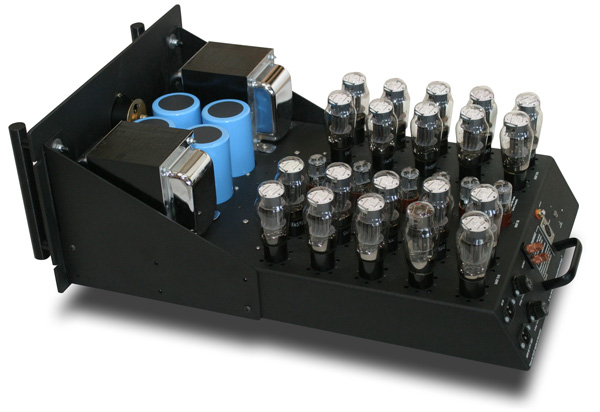![[SoundStage!]](../titles/sslogo3.gif) Home
Audio Home
Audio Equipment Review |
|||||
Ralph Karsten, head of Atma-Sphere Music Systems, wrote this in a provocative article that discusses two paradigms with relevance to the design and measurement of audio products. On the one hand is the Voltage Paradigm, which, Ralph asserts, "is the reigning design, test and measurement paradigm for amplifiers and loudspeakers." It "assumes that the voltage response of an amplifier is the only aspect of the amplifier that matters." He goes on to explain that "Amplifiers with a constant voltage characteristic are considered 'load impervious.'" "In other words…the amplifier will make a different amount of power depending upon the load impedance," often doubling power output as load impedance is cut in half. According to Ralph, "Transistor amplifiers are almost entirely in the Voltage Paradigm camp, and they "inherently employ a fair amount of negative feedback." Conversely, the Power Paradigm "assumes that amplifiers produce power and speakers are power-driven." "Under this model, the ideal amplifier will make the same power into all loads, 4, 8 and 16 ohms." "The typical amplifier in this case is a tube amplifier" with "little or no feedback." Why the distinction? Sound quality, of course. As Ralph puts it, "Voltage Paradigm adherents will state that that character is based on distortion, but the truth of the matter is that what is really at the heart of it is the lack of distortions that humans find objectionable. In other words, this approach is based on the reality of real-world human hearing, rather than a thought model." Maybe it's coincidence that Ralph has begun to record his thoughts on designing audio equipment, but I think that it has something to do with what he went through in 2004, when a former business partner attempted to buy him out and then remove him from the company that has become synonymous with his audio designs. Would there be an Atma-Sphere without Ralph Karsten? I suppose it could have been possible for the company to limp along for a while, but Ralph is Atma-Sphere, the company's most vital asset. You can see a remnant of the failed buyout on the version of Ralph's MA-2 amplifier I received for review, the Mk III ($32,800 USD per pair). There's a Class A/Class A/B switch on the front panel of an amplifier that has always been proud of its fully balanced, pure-class-A output. "We still offer [the switch] as an option, but no one buys it," Ralph admits. "I think it sucks." He's right -- it does, and it's wrongheaded. The MA-2 Mk III puts out 220 watts per channel; if you need the added power that switching to class A/B would bring, you need to buy Ralph's monster MA-3s -- or some solid-state bruiser.
I wrote about the previous version of the MA-2, the Mk II.3, in early 2004, and it was a highlight of my work that year. I ended my review by saying, "To 'settle' for such amps is the thing of which audiophile dreams are made." The MA-2 Mk III looks nearly identical and uses the same 20 6AS7G output and six 6SN7GT driver tubes. The biggest outward change is a new auto-bias circuit -- no more negotiating spring-loaded toggle switches and hard-to-see pots to set the bias. Inside, the amp has a new output section and uses a pair of V-Cap Teflon coupling capacitors in the driver circuit. Ralph selects passive parts carefully, and as he finds new parts that simply sound better, he incorporates them into each update, which is often no easy feat given the meticulous point-to-point wiring he insists on. If you have your MA-2s updated, Ralph and his crew of dedicated technicians will also replace the front panel and meter, and reactivate your warranty to a full three years. Heck, a brand-new warranty is almost worth the $3300-per-pair upgrade cost all by itself. Even though it has been nearly three years since I've heard the MA-2 Mk II.3s, I easily remembered their sonic signature once I sat down to listen to the Mk IIIs. There was clarity without edginess, a wholly lucid, intelligible sound. No other tube amp that I'm aware of sounds quite as pure and direct as the MA-2 Mk III -- must be an OTL thing. It's as though the light on the music is just a little -- or, depending on the amp you're using now, a lot -- brighter and better able to reveal contrast and texture. The MA-2 Mk III does the sort of things that make listening to high-performance audio equipment memorable. There are no tricks or gimmicks, just a lithe and animated portrayal of orchestra or jazz ensemble, rock band or solo guitar. Where the MA-2 Mk III's clarity struts most is in the midrange, which is more transparent than that of any amplifier I've heard. In fact, in this regard, there really isn't an amp I've heard that rivals the MA-2 Mk III, so immediate and uncolored is its way with vocals and any instrument reproduced through the midband. Among my recent musical finds is Lucinda Williams' latest stellar collection, West [Lost Highway 0602498583487]. Williams' voice is nasally and rough around the edges -- perfect for her songs, which blend country twang with folk introspection and some rock'n'roll tendencies. The lucidity that the MA-2 Mk IIIs bring to Williams' singing is startling at first. Such distinctness and openness often come at the price of at least some fine grain or exaggerated edge definition, which can give the illusion of great clarity until you notice what's underlying it. But the MA-2 Mk IIIs sound too uncontrived, too natural, for this, instead acting as conduits from preamp to speaker. You can certainly hear into recordings with these amps, but the novelty of this wears off as you marvel at the astonishing transparency of the midrange. "Abundant purity, the sense that I was hearing more of the authentic musical signal and less of that signal overlaid with artifacts of reproduction" was the way I stated it in my review of the MA-2 Mk II.3 amps, and it's no surprise that the Mk IIIs sound the same way. The MA-2 Mk IIIs also cast a deeply arcing soundstage with image outlines that are distinct and separate, just as with the previous version of the amps. Since my earlier review, I have come across some amps, namely from Audio Research, that re-create a subjectively wider soundstage, but the MA-2s Mk IIIs are still in the 90th percentile. The Atma-Sphere amps delineate performers in the space they conjure better than any amp I've heard, putting them among the best portrayers of the musicians' physical presence. As you may be able to guess, they don't accomplish this through tubey bloom or warmth, but rather via an unforced resolution that is the earmark of the highest performance high-end audio has to offer.
You won't buy MA-2 Mk IIIs specifically for their bass, which happens to go as deep as that of their tubed competition but is not as full and fat. Like that of most tube amps, the MA-2 Mk IIIs' bass turns soft at a point where a solid-state amp will continue to extend. However, this seems like all show, as the pistonic character of such bass can impart a mechanical pall to the music. While I recognize that solid-state bass goes lower and has greater power and slam than that of an amp like the MA-2 Mk III, I just don't find it musically interesting. Maybe I've been listening to tubes for too long, or maybe audiophiles and audio reviewers should remember that music lives between the frequency extremes. Or maybe Ralph Karsten is onto something with the Power Paradigm. There are signs. The Conrad-Johnson Premier 350 and Audio Research Reference 110, stereo amplifiers that I recently reviewed and absolutely loved, don't double in output power as impedance is halved, and the solid-state Premier 350 doesn't employ any global feedback. Additionally, two SoundStage! writers recently wrote about Atma-Sphere amplifiers in glowing terms and purchased units from Ralph after their reviews. Then there is the MA-2 Mk III -- one of the elite amplifiers you can buy and the standard bearer for the Power Paradigm. Give a pair a listen and decide for yourself if what Ralph has "assumed, neglected or idealized" seems correct to your ears. He's right on the mark according to mine. ...Marc Mickelson
|
|||||
|
|||||
![[SoundStage!]](../titles/sslogo3.gif) All
Contents All
ContentsCopyright © 2007 SoundStage! All Rights Reserved |



 But don't let its
high power fool you into thinking that the latest MA-2 is about brute force and not
finesse. The MA-2 has always been an amp for connoisseurs, but one that doesn't have the
power limitations of many exotic designs. It can drive the big speakers -- like my Wilson
Audio MAXX 2s -- with which it would likely be used. While OTLs like high-impedance loads,
the MA-2 has always been more immune to the load a particular speaker presents than
Ralph's other amps because of its ample tube complement and power output.
But don't let its
high power fool you into thinking that the latest MA-2 is about brute force and not
finesse. The MA-2 has always been an amp for connoisseurs, but one that doesn't have the
power limitations of many exotic designs. It can drive the big speakers -- like my Wilson
Audio MAXX 2s -- with which it would likely be used. While OTLs like high-impedance loads,
the MA-2 has always been more immune to the load a particular speaker presents than
Ralph's other amps because of its ample tube complement and power output.